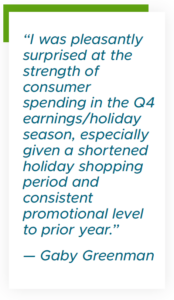Perspectives
Keep
Reading

Domestic Equities Market Commentary – 1Q 2025
Domestic Equity | InsightWhereas the only certainty for the near-term would seem to be more market volatility, investor sentiment has turned so negative that a relief rally can’t be ruled out.
Read Article
Consumer Spending Faces Crosswinds After Strong 2024
Macro, Domestic Equity | InsightWill consumers stay resilient or pullback? Our Global Strategist Bill Sterling shares his research on spending trends and what they mean for investors.
Read Article
Perspectives on the US Equity Market Selloff
Macro, Domestic Equity | InsightGlobal Strategist Bill Sterling shares his research into historical stock market corrections – including how extreme uncertainty can be followed by surprisingly positive stock market returns.
Read ArticleThis Website Uses Cookies
We use cookies to improve your experience on our website. To accept cookies click Accept & Close, or continue browsing as normal. For more information or to learn how to opt out of cookies, please see our cookie policy.
Accept and CloseStay Updated & Informed with GW&K
GW&K's CIO and Portfolio Managers share their insights and opinions on the economy and market each quarter.
-
Latest Insight
How Reliant is the Municipal Market on Federal Funding?
Municipal Bond
Even amid recent volatility, municipal bonds continued to behave as you’d expect from one of the more stable corners of fixed income.
Download -
Latest Market Commentary
State Of The States 2025 — Poised For Fiscal Stability
Municipal Bond
Fiscal conditions across state governments remain healthy as the sector heads into 2025.
Read Article
Company Insights on Consumer Spending
GW&K Insights | March 2025
Beyond the economic data GW&K’s Global Strategist Bill Sterling reviews in his latest article, “Consumer Spending Faces Crosswinds After Strong 2024,” corporate earnings calls provide a real-time look at how businesses perceive the financial health of the US consumer. We asked GW&K’s Equity Analyst Gaby Greenman about her key takeaways from the latest company earnings reports.
Q: Gaby, what is the tone of the companies you follow coming out of the latest quarter?
Gaby Greenman: They are cautious. Retailers in the US are currently navigating a dynamic landscape, marked by both resilience and caution. Spending for the holiday season in 2024 was stronger than expected, and while colder, wintry weather and California wildfires impacted January and to some extent, February, consumer sentiment has since fallen, and we are seeing a mild slowdown more recently.
As a result, many companies are setting cautious guidance targets for 2025, with many estimates coming in below Wall Street’s expectations. Many company management teams have held off on including tariff assumptions in their outlooks because of the changing headlines. But most have spoken about possible mitigation efforts like price increases, vendor concessions, and driving further operational efficiencies. In addition, many are pulling forward inventories ahead of potential tariffs given the uncertainty.
Q: How are you factoring in potential changes to the US labor market due to government cutbacks?
Gaby: I am laser focused on trends in the labor market for insights into potential consumer spending. The jobs situation remains very fluid and is, at this time, difficult to quantify. US government civilian employees ex the Post Office, make up just 1.5% of total non-farm payrolls, but the federal contractor labor force is double that, and these jobs could also be impacted by government cutbacks. We have already seen an uptick in initial unemployment claims from federal programs and that is likely to continue going up. In addition, the federal employees who took a deferred resignation offer are not likely to show up in the claims data until the fourth quarter.
Q: What items will be affected the most by the tariffs that have been announced?
Gaby: Not as many as you think, because many companies have already started diversifying their supply chains in the last five years. This effort began in response to the 2018/19 Chinese tariffs, and then increased during the pandemic, when goods production was further disrupted by various country shut downs.
That said, in today’s tariff schema, some industries like toys and electronics have relatively higher exposure to Chinese tariffs, though less than in 2018/19. The auto industry has outsized exposure to the 25% Mexican tariffs. The 25% steel and aluminum tariffs will also impact autos (the bestselling truck in the US, the Ford F-150, has had an aluminum body since 2015), boats, ATVs, RVs, and motorcycles. There are smaller categories like avocados and limes where Mexico is a very significant supplier of these items to the US. And the Canadian tariffs are likely to impact housing, which is already stressed by affordability issues.
Q: What are you seeing in the US housing sector?
Gaby: The US housing market has been under pressure for the last two years. We have a structural shortage of housing due to underbuilding in the US, homeowners being reluctant to sell because they are locked into low mortgage rates, still high mortgage rates for buyers, significant home price inflation post the pandemic, and inflation in key housing expenses like insurance. All of these things have created an affordability crisis.
Larger homebuilders have been able to use their size/scale and balance sheets (stronger after the great financial crisis) to help consumers finance their new home purchases by offering below- market-rate mortgages, through their internal financing operations. They can also take share from smaller builders who have higher exposure to illegal immigration risk. However, the affordability issues coupled with increased uncertainty around jobs and tariff-induced inflation only serve to lengthen any recovery in this typically seasonal sector. Longer term, if affordability issues ease, housing demand is likely to come back.
Q: What is your biggest takeaway from 4Q24 earnings season?
Gaby: I was pleasantly surprised at the strength of consumer spending in the Q4 earnings/holiday season, especially given a shortened holiday shopping period and consistent promotional level to prior year. The recent slowdown is indicative of the high level of uncertainty that US consumers are experiencing at this moment. Most companies, not knowing where tariffs and other potential policy changes will land, expect more of what they saw in 2024 for 2025: a discerning consumer, thoughtful about their purchases but willing to spend on value, newness, and convenience. At the same time, they acknowledge the effect consumer psychology has on spending and are buckling down for a great deal of near-term volatility.
Gabriela L. Greenman
Partner, Research AnalystDisclosures
This represents the views and opinions of GW&K Investment Management and does not constitute investment advice, nor should it be considered predictive of any future market performance. Data is from what we believe to be reliable sources, but it cannot be guaranteed. Opinions expressed are subject to change. Past performance is not indicative of future results.
Indexes are not subject to fees and expenses typically associated with managed accounts or investment funds. Investments cannot be made directly in an index. Index data has been obtained from third-party data providers that GW&K believes to be reliable, but GW&K does not guarantee its accuracy, completeness or timeliness. Third-party data providers make no warranties or representations relating to the accuracy, completeness or timeliness of the data they provide and are not liable for any damages relating to this data. The third-party data may not be further redistributed or used without the relevant third-party’s consent. Sources for index data include: Bloomberg, FactSet, ICE, FTSE Russell, MSCI and Standard & Poor’s.